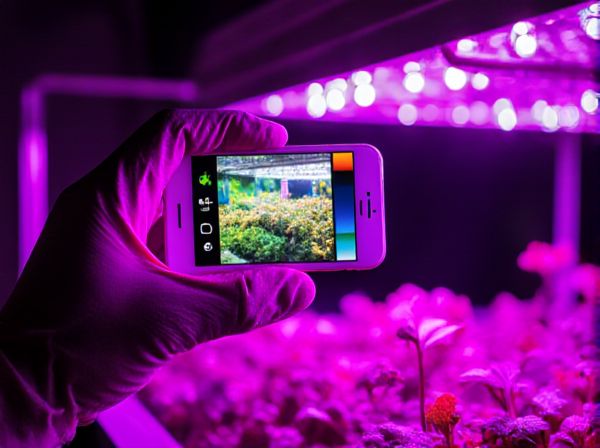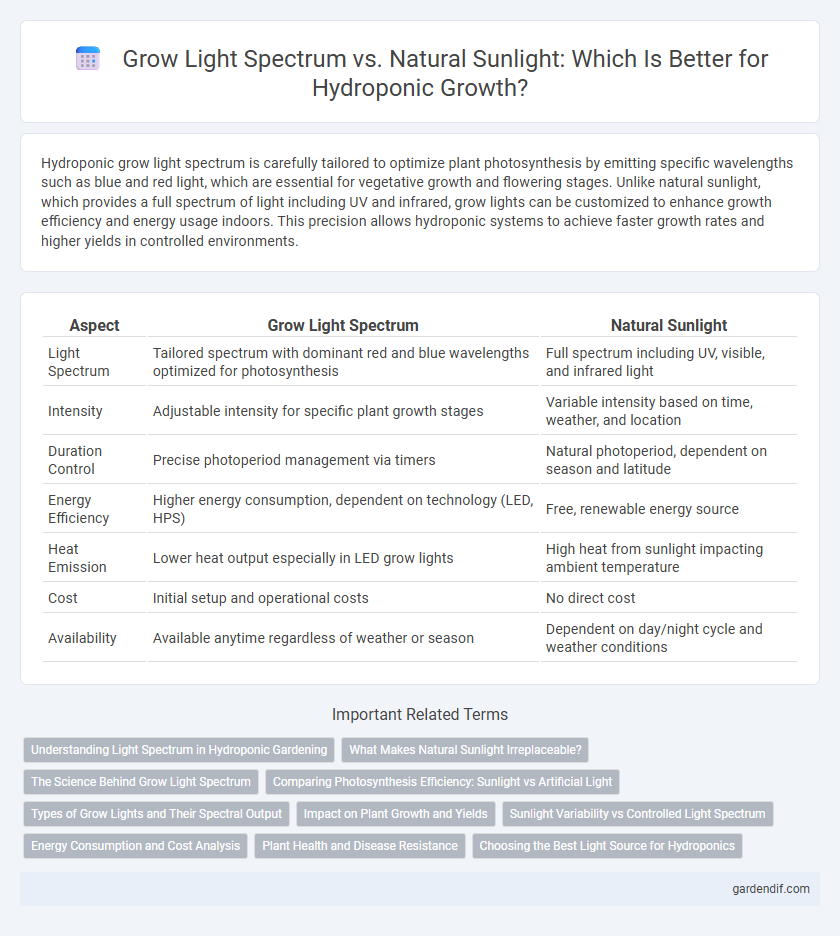
Grow Light Spectrum vs Natural Sunlight Illustration
Hydroponic grow light spectrum is carefully tailored to optimize plant photosynthesis by emitting specific wavelengths such as blue and red light, which are essential for vegetative growth and flowering stages. Unlike natural sunlight, which provides a full spectrum of light including UV and infrared, grow lights can be customized to enhance growth efficiency and energy usage indoors. This precision allows hydroponic systems to achieve faster growth rates and higher yields in controlled environments.
Table of Comparison
| Aspect | Grow Light Spectrum | Natural Sunlight |
|---|---|---|
| Light Spectrum | Tailored spectrum with dominant red and blue wavelengths optimized for photosynthesis | Full spectrum including UV, visible, and infrared light |
| Intensity | Adjustable intensity for specific plant growth stages | Variable intensity based on time, weather, and location |
| Duration Control | Precise photoperiod management via timers | Natural photoperiod, dependent on season and latitude |
| Energy Efficiency | Higher energy consumption, dependent on technology (LED, HPS) | Free, renewable energy source |
| Heat Emission | Lower heat output especially in LED grow lights | High heat from sunlight impacting ambient temperature |
| Cost | Initial setup and operational costs | No direct cost |
| Availability | Available anytime regardless of weather or season | Dependent on day/night cycle and weather conditions |
Understanding Light Spectrum in Hydroponic Gardening
Understanding the light spectrum in hydroponic gardening is crucial for optimizing plant growth, as different wavelengths influence various biological processes such as photosynthesis and flowering. Grow lights are designed to emit specific light spectra, typically focusing on blue (400-500 nm) and red (600-700 nm) wavelengths, which are essential for vegetative growth and flowering stages, respectively. Unlike natural sunlight, which offers a full spectrum of light, tailored grow light spectra ensure consistent and targeted light delivery, enhancing crop yield and quality in controlled indoor environments.
What Makes Natural Sunlight Irreplaceable?
Natural sunlight provides a full spectrum of light, including ultraviolet and infrared wavelengths, which are crucial for plant growth, photosynthesis, and development. The dynamic intensity and angle of sunlight throughout the day promote stronger, healthier plants by mimicking natural environmental conditions. Furthermore, sunlight delivers essential energy that artificial grow lights struggle to replicate entirely, making it irreplaceable for optimal hydroponic crop yields.
The Science Behind Grow Light Spectrum
Grow light spectrum replicates specific wavelengths of natural sunlight essential for photosynthesis, primarily red and blue light, which stimulate chlorophyll absorption and maximize plant growth. Advances in LED technology enable precise control over light intensity and spectrum, optimizing plant development and energy efficiency beyond what natural sunlight can consistently provide. Understanding the science behind grow light spectrum allows growers to tailor light conditions for different growth stages, enhancing biomass production and crop yield in hydroponic systems.
Comparing Photosynthesis Efficiency: Sunlight vs Artificial Light
Photosynthesis efficiency is strongly influenced by the light spectrum, with natural sunlight offering a broad range of wavelengths essential for plant growth, including the full visible and near-infrared spectrum. Artificial grow lights can be optimized to deliver targeted spectra, primarily red and blue wavelengths, which are most effective for photosynthesis, potentially improving energy use efficiency in hydroponic systems. Despite this, natural sunlight remains more efficient overall due to its intensity and complete spectral range, but advances in LED technology are narrowing the gap by enhancing photosynthetic photon flux density (PPFD) and tailored light spectra.
Types of Grow Lights and Their Spectral Output
LED grow lights provide targeted spectral output, typically offering full-spectrum light that mimics natural sunlight with peaks in blue (400-500 nm) and red (600-700 nm) wavelengths, essential for photosynthesis and plant development. Fluorescent grow lights deliver a balanced spectrum suited for seedlings and leafy greens, featuring strong blue light but weaker red wavelengths compared to sunlight. High-Intensity Discharge (HID) lights, including Metal Halide (MH) and High-Pressure Sodium (HPS), emit intense, broad-spectrum light with MH favoring blue spectra for vegetative growth and HPS emphasizing red-orange spectra to promote flowering, closely aligning with stages of plant growth in hydroponic systems.
Impact on Plant Growth and Yields
Grow light spectrum can be precisely tailored to emit specific wavelengths, such as blue and red light, which are essential for photosynthesis and enhancing plant growth, resulting in optimized yields compared to natural sunlight's broad but variable spectrum. Natural sunlight provides a full spectrum that supports overall plant development, but its intensity and duration fluctuate, potentially limiting consistent growth and production. Controlled grow light systems allow for extended photoperiods and spectrum customization, boosting photosynthetic efficiency and crop yield in hydroponic setups.
Sunlight Variability vs Controlled Light Spectrum
Natural sunlight offers a full spectrum of light wavelengths essential for plant growth but varies significantly due to weather, time of day, and seasonal changes, impacting photosynthesis consistency. Grow lights provide a controlled light spectrum tailored to optimize photosynthetic efficiency by delivering consistent intensity and wavelength distribution year-round. This controlled environment enhances plant growth predictability and crop yield compared to the fluctuating nature of natural sunlight.
Energy Consumption and Cost Analysis
Grow light spectra are designed to maximize photosynthetic efficiency by emitting specific wavelengths tailored to plant needs, resulting in controlled energy consumption compared to the broad spectrum of natural sunlight. Hydroponic growers often experience lower operational costs using energy-efficient LED grow lights, which consume less electricity and reduce heat output, unlike traditional lighting or dependency on variable sunlight. Cost analysis reveals that while initial investment in grow lights can be higher, long-term savings on energy bills and increased crop yields can offset these expenses more effectively than relying solely on natural sunlight.
Plant Health and Disease Resistance
Grow light spectrum tailored to plant-specific wavelengths enhances photosynthesis efficiency and improves plant health compared to natural sunlight, which varies in intensity and spectral quality. Optimized grow lights regulate red, blue, and far-red light ratios critical for chlorophyll production, promoting stronger cell walls and increased resistance to pathogens. Controlled spectral environments reduce stress factors and disease susceptibility, resulting in more robust hydroponic crop yields.
Choosing the Best Light Source for Hydroponics
Choosing the best light source for hydroponics involves comparing grow light spectrum and natural sunlight based on plant growth efficiency and energy costs. Grow lights, such as full-spectrum LEDs, can be tailored to emit specific wavelengths that optimize photosynthesis and enhance crop yields indoors. Natural sunlight provides a complete spectrum and free energy but may be inconsistent and limited by geographical location, requiring growers to balance control, cost, and light quality for optimal hydroponic crop production.
Grow Light Spectrum vs Natural Sunlight Infographic

 gardendif.com
gardendif.com